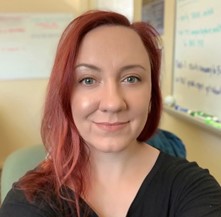

Written by: Alexis McIntyre
Dr. Alicia Aarnio is an astrophysicist and Assistant Professor at The University of North Carolina at Greensboro. She graduated from Smith College, a women’s college, in 2005 double majoring in astronomy and physics. She then attended Vanderbilt where she earned her Ph.D. in Physics in 2010, a year in which only 20% of Physics PhDs were conferred to women. Since beginning with a Research Experience for Undergraduates (REU) project, Dr. Aarnio has been in the field for 19 years, and when not teaching and conducting research, she loves to make, repair, and grow things. Dr. Aarnio enjoys knitting (with the yarn she spins herself!), and she is constantly tinkering with different home improvement projects such as restoring an antique spinning wheel or gardening.
Dr. Aarnio has always been interested in science and had dreamt of becoming a marine biologist until realizing she might have to learn how to swim. Fortunately, by high school her interests had shifted toward land-based pursuits: astronomy, chemistry, Spanish, and music composition/conducting. She ended up choosing a liberal arts college because all those options would be available to her, and she figured she could decide on her field later.
Dr. Aarnio credits her progress to the concerted efforts and encouragement of many folks dedicated to fostering the success of women in science. As an undergraduate at Smith, she never felt out of place as a woman in a physics class. It wasn’t until later in her academic career that she was faced with the solitude of being a woman in a male-dominated field. Those early experiences helped her build up some resilience to the isolation that followed. Dr. Aarnio has had many amazing teachers, advisors, and mentors who have supported her and made sure that she had access to many opportunities. As a faculty member today, Dr. Aarnio is honored to now be the one who can support and encourage the students working with her.

- Observational astrophysics: Dr. Aarnio is currently assembling an atlas of spectra for young stars that are a few times more massive than the Sun. These stars are interesting because she is only able to detect magnetic fields on about 10% of them, a much lower rate than expected. These stars are in-between sun-like stars (interesting to study because she wants to understand where we came from) and high-mass stars (interesting because their brief lives end in supernovae), and so these in-between stars have been rather overlooked.
- Computational astrophysics: To really dig into these mysterious stars with undetectable magnetic fields, Dr. Aarnio is running a magnetohydrodynamic (magneto=with magnetic fields; hydro=material that is fluid-like; dynamic= moving around) simulation to build them from scratch to see what their magnetic fields might be like. She suspects that they are very complex, and this is why we are unable to detect them observationally.
- Accessible Astronomy: Dr. Aarnio co-founded, co-chaired, and currently serves as a coordinating committee member of the American Astronomical Society Working Group on Accessibility and Disability: the group has been working on recommendations to make publications, meetings, and databases accessible to astronomers with disabilities. Dr. Aarnio has recently published a white paper for the Astro 2020 Decadal Survey, which she hopes will spotlight the underrepresentation and generally very negative experiences of disabled people pursuing astrophysics research careers. Lastly, Dr. Aarnio currently is working on a paper about accessibility post-COVID, highlighting how current adaptations should keep moving forward as they could remove barriers to access and allow for broader participation in research
Selected Publications from the Aarnio lab and Websites:
Website: http://aliciaaarnio.solar/stellar
WGAD site: http://wgad.aas.org
Aarnio et al. 2019, Astro2020 APC White Paper: Accessible Astronomy: Policies, Practices, and Strategies to Increase Participation of Astronomers with Disabilities, for the National Academies Astro2020, https://arxiv.org/abs/1907.04943
Aarnio et al. 2017, High-cadence, High-resolution Spectroscopic Observations of Herbig Stars HD 98922 and V1295 Aquila, The Astrophysical Journal, https://arxiv.org/abs/1710.11322
Kraus et al. 2021, A triple star system with a misaligned and warped circumstellar disk shaped by disk tearing, Science, https://arxiv.org/abs/2004.01204